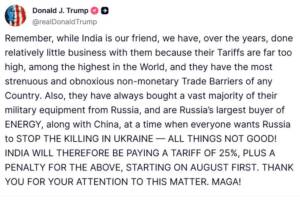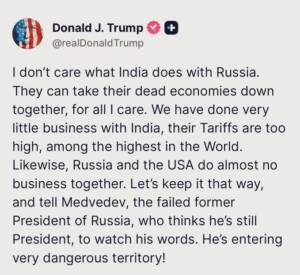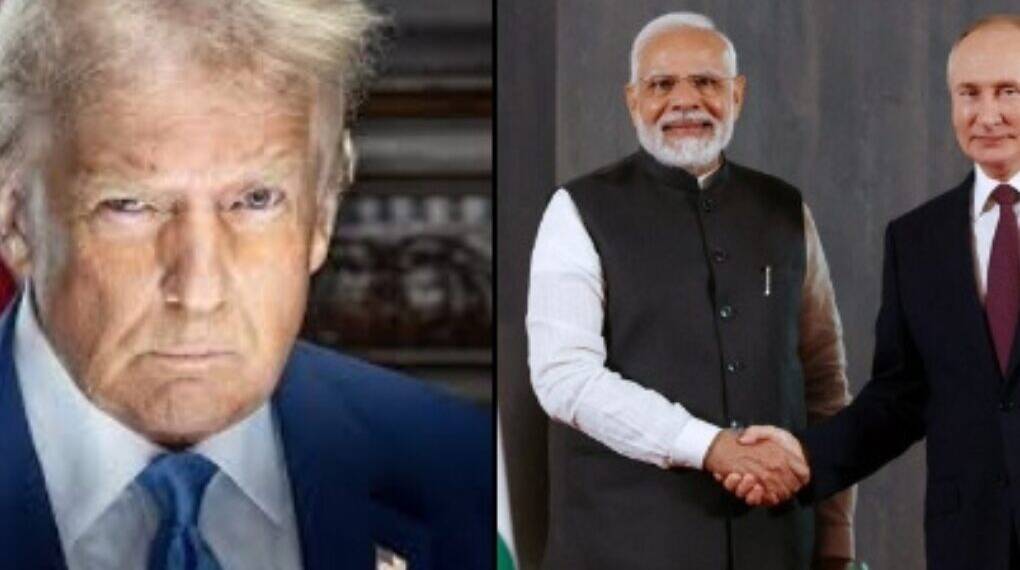In a move that has sent shockwaves through global trade markets, U.S. President Donald Trump has announced a sweeping 25% tariff on Indian imports, accompanied by a vague but potent threat of additional penalties targeting India’s energy purchases from Russia.

The new tariffs, which come into effect on August 1, mark one of the harshest trade actions against an Asian nation during Trump’s second presidential term, and risk further straining ties between Washington and New Delhi.
Tariffs and Frustrations: Why Trump Targeted India
The decision stems from what White House officials describe as Trump’s frustration with the sluggish progress in ongoing trade negotiations between the two countries. National Economic Council Director Kevin Hassett emphasized that President Trump was discontent with India’s protectionist policies and limited market access for U.S. goods, noting that while the U.S. market is open to Indian products, India maintains steep tariffs—especially on agricultural goods, where rates hover between 39% and 50%.
Trump reiterated this concern on his social media platform, Truth Social, claiming, “India has some of the highest tariffs in the world, as high as 175% in some cases. This is not acceptable.”
India’s Continued Ties with Russia Also Under Fire
The trade tensions are further exacerbated by India’s ongoing purchase of discounted Russian oil amid the war in Ukraine. Trump has warned that continued energy trade with Russia may lead to secondary sanctions, compounding the damage from the 25% import tariff.

“They can take their dead economies down together, for all I care,” Trump remarked in one of his harshest criticisms, referring to India and Russia.
India is currently the second-largest buyer of Russian fossil fuels after China, importing roughly 35% of its oil from Russia—a steep rise from less than 1% before 2022.
Indian Government’s Response: ‘Assessing the Implications’
India’s Ministry of Commerce, led by Piyush Goyal, acknowledged the U.S. announcement and confirmed that it is assessing the situation. In a statement, the ministry reaffirmed India’s commitment to pursuing a fair and mutually beneficial trade deal.
“The government attaches utmost importance to protecting our farmers, entrepreneurs, and MSMEs. All steps necessary will be taken to secure our national interest,” the statement read.
Strategic Rivals and Regional Winners
While India faces higher costs in accessing the U.S. market, Southeast Asian nations stand to gain. Vietnam, which competes directly with India in textiles, electronics, and seafood, faces a lower 20% tariff and has already secured a trade deal with the U.S., giving it a clear advantage. Indonesia and the Philippines, with 19% tariffs, are also positioned to benefit.
In contrast, India’s South Asian neighbors, such as Bangladesh (35% tariff) and Pakistan (29%), face even steeper barriers, curbing their competitiveness.
Pakistan-U.S. Oil Deal Raises Eyebrows
Further complicating regional dynamics, Trump announced a new U.S.-Pakistan oil development deal, signaling potential energy cooperation between the two countries. In a provocative twist, he suggested that Pakistan might one day sell oil to India.
“We have just concluded a deal with Pakistan to develop their massive oil reserves. Who knows, maybe they’ll be selling oil to India someday!” Trump said on Truth Social.
Tariffs: Negotiating Tactic or New Trade Doctrine?
Former U.S. Assistant Secretary of State Nisha Biswal downplayed the tariffs as a hardline negotiating tactic. She noted that both sides were close to finalizing a trade agreement before Trump’s announcement and that negotiations remain ongoing.
“The President isn’t in a ‘part of the way’ mood—he wants barriers removed completely or as close to completely as possible,” a U.S. trade official told CNN.
Market Reaction: Indian Equities Slide
The impact was immediate on Indian financial markets. The Nifty 50 index slipped 0.61%, while the BSE Sensex dropped 0.64%, with all major sectors logging losses. Small-cap and mid-cap indices also fell nearly 1%.
Looking Ahead: Trade Talks Continue Amid Threats
Despite the rhetoric, Trump left the door open for negotiations: “We are still talking to them now. We’ll see what happens.” His administration remains in contact with Indian officials, although insiders suggest Trump is using the tariffs to apply pressure ahead of finalizing any deal.
With the August 1 deadline looming and uncertainty swirling around the nature of the “penalty” for India’s Russia ties, businesses on both sides of the Pacific are bracing for more turbulence.








